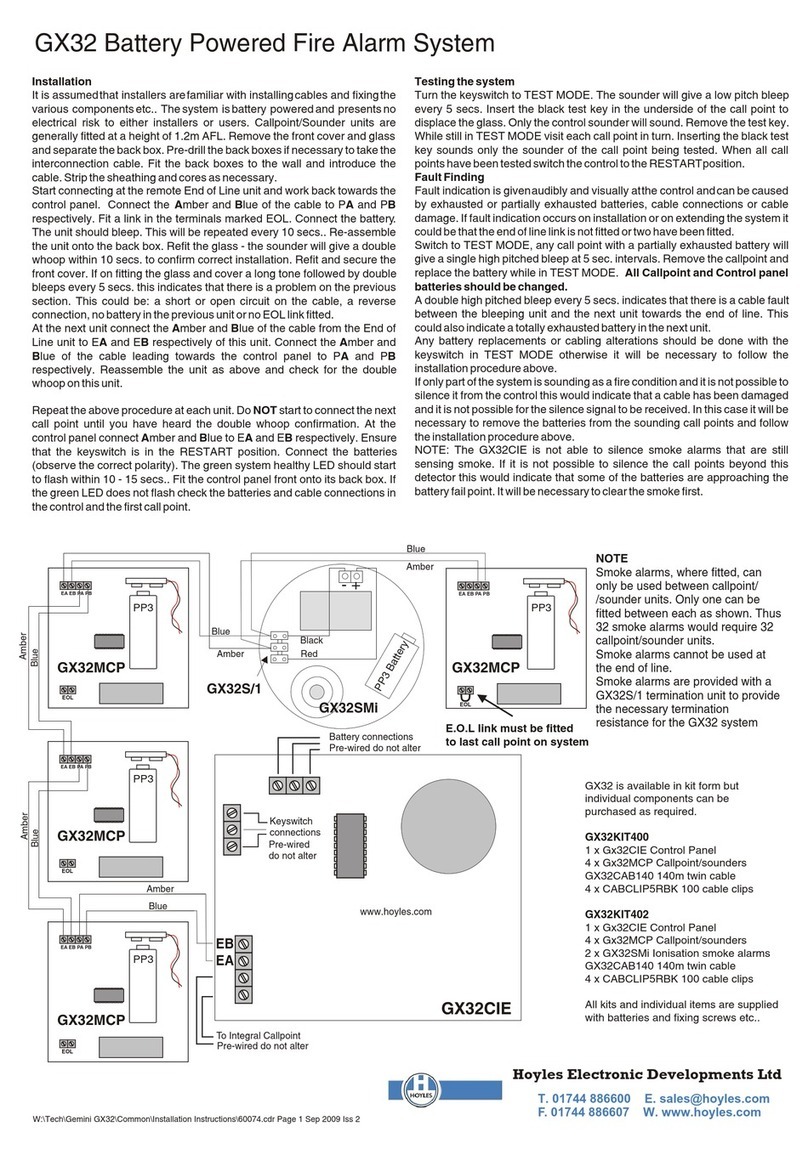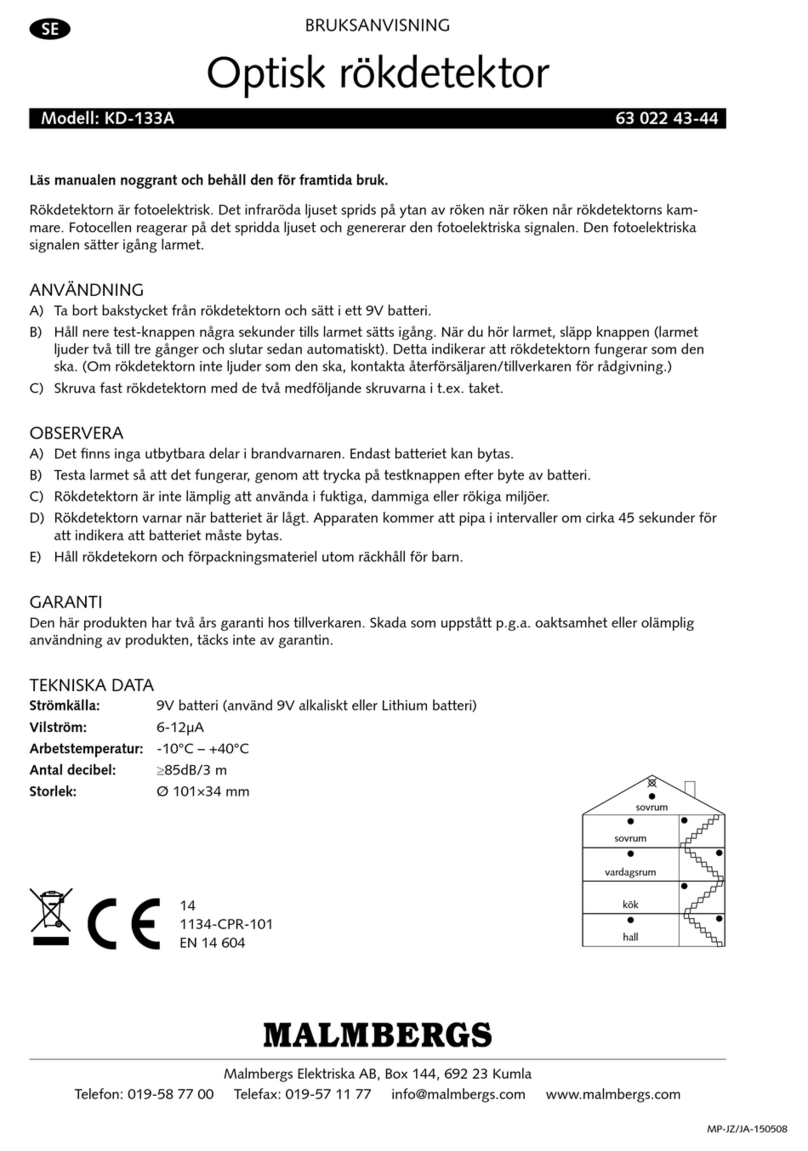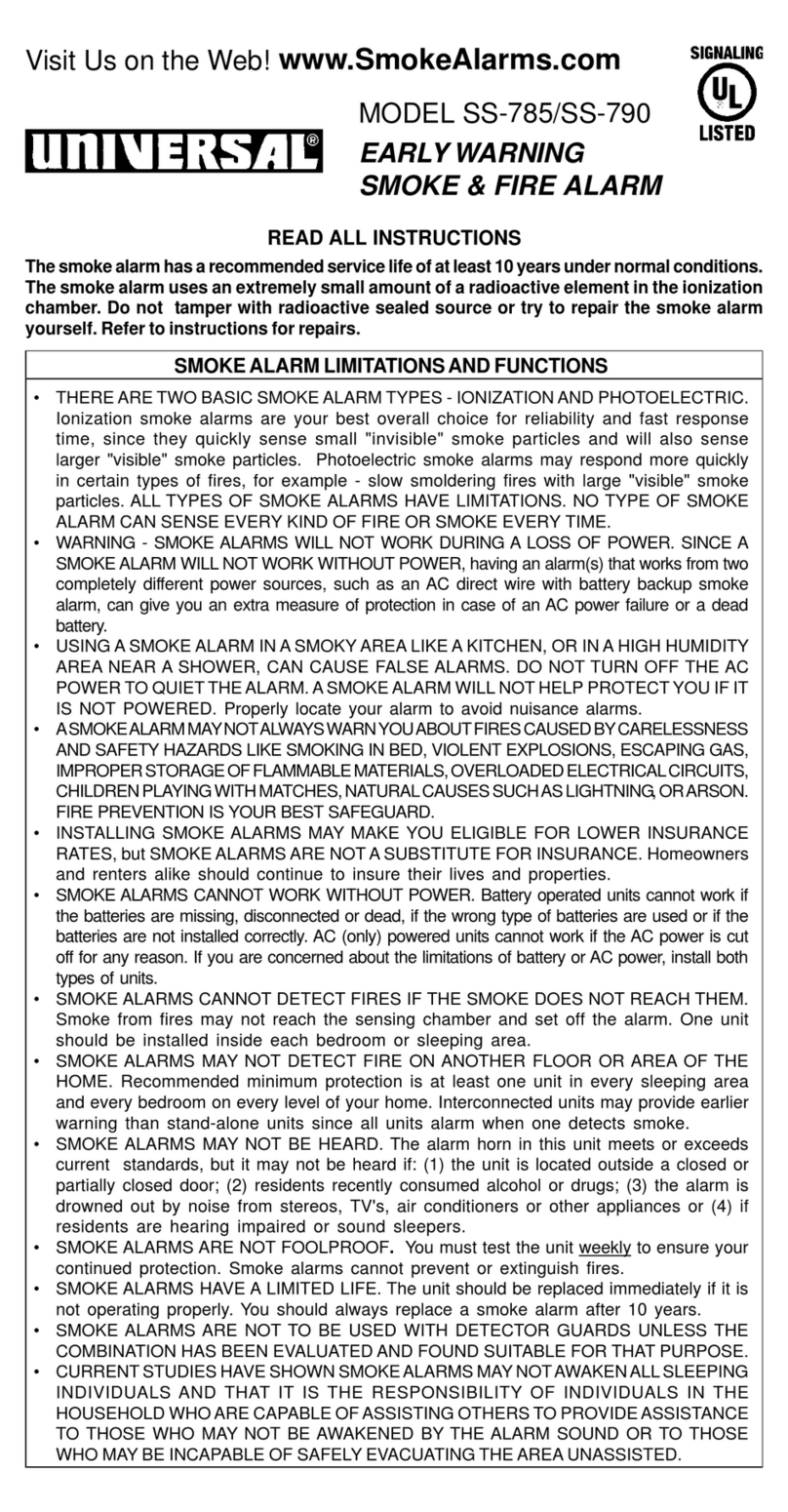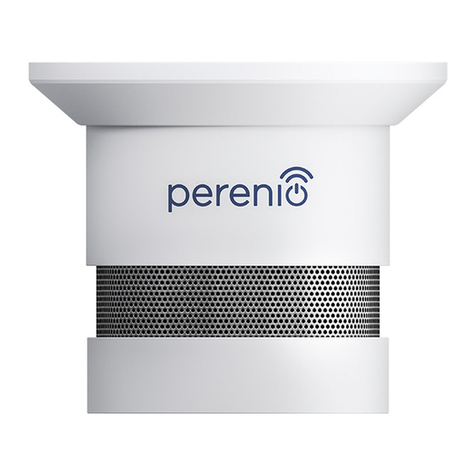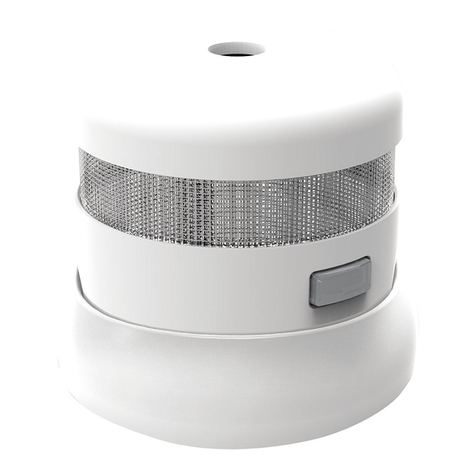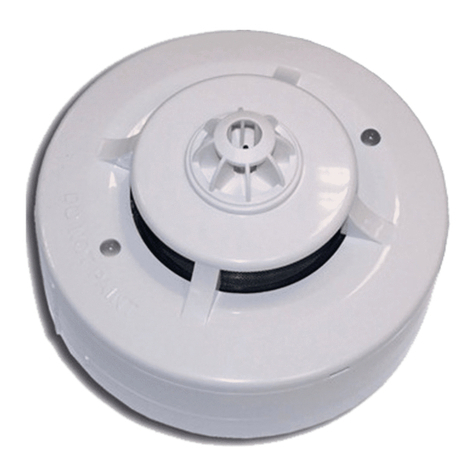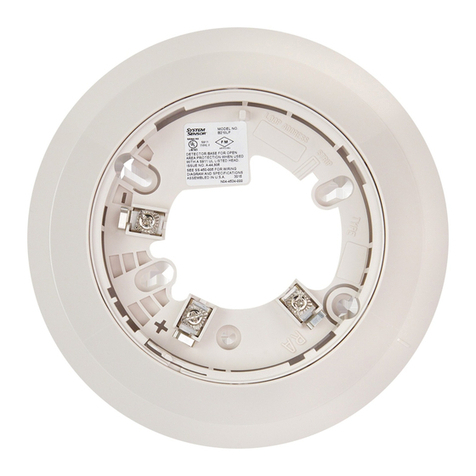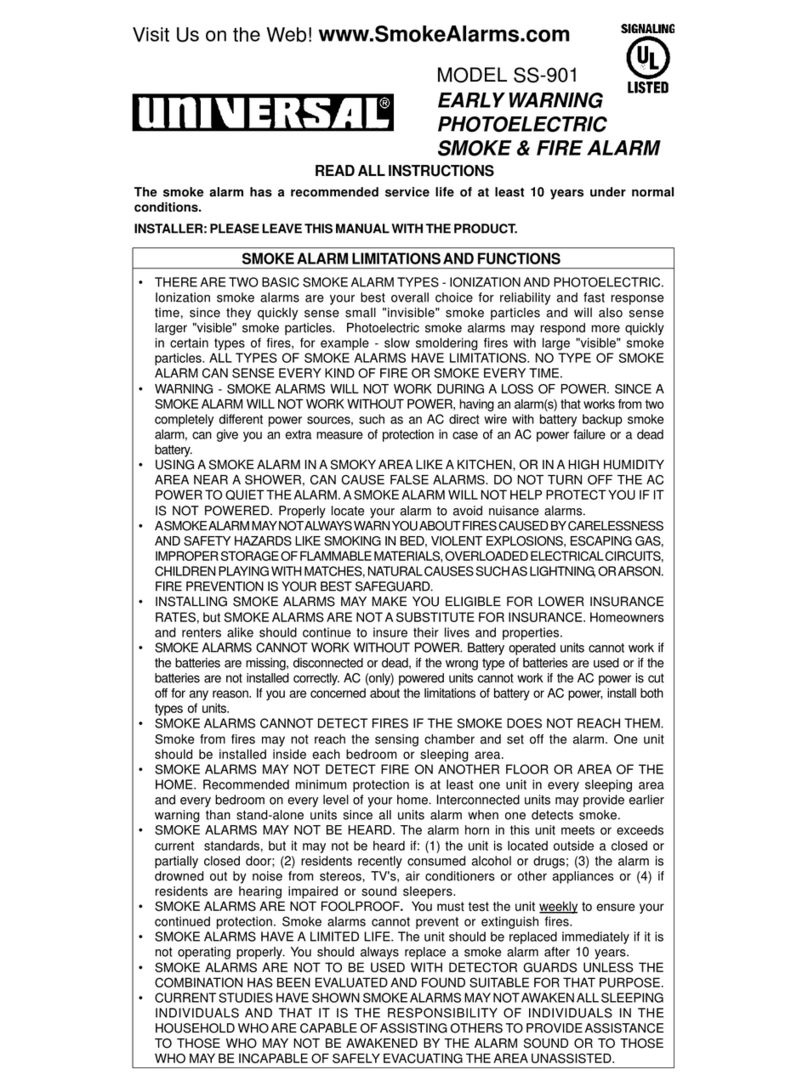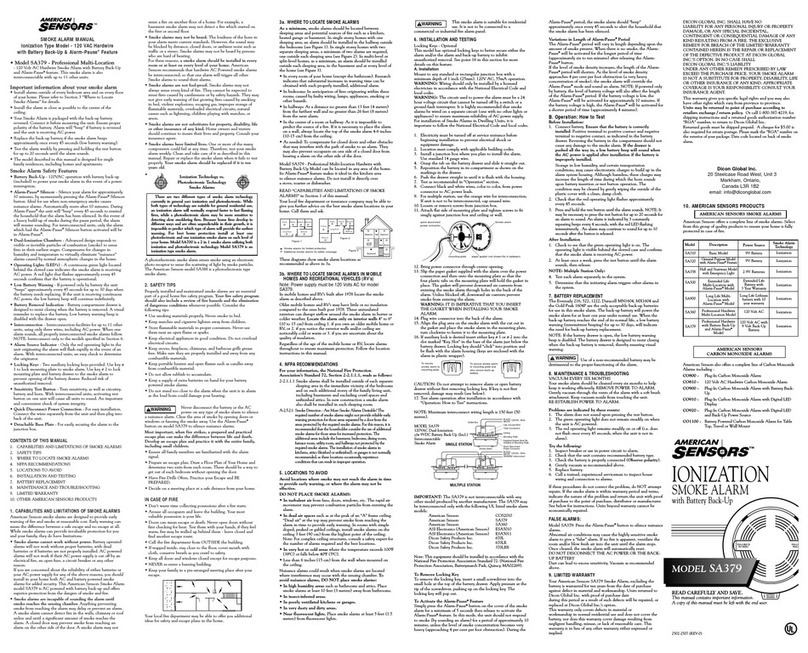SimpliSafe CA002 User manual

Smoke/CO Detector
Owner’s Manual
IMPORTANT! Please read this Owner’s Manual carefully
before installation and use. Save this manual.
Model: CA002
CA002-IFU2

Table of Contents
(1) Product Information ................................... 1
a. Smoke Detection
b. Carbon Monoxide (CO) Detection
(2) Important Warning Statements . . . . . . . . . . . . . . . . . . . . . 2
(3) Installation and Location ............................. 7
a. Smoke/CO Detector Placement
b. Locations to Avoid
c. Installing the Smoke/CO Detector
d. Battery Installation
e. Pairing to the Base Station
f. Verify Pairing and RF Communication Between
Smoke/CO Detector and Base Station
(4) Usage, Operation and Operating Mode . . . . . . . . . . . 1 7
a. Normal Operation Testing
b. Silence Feature
c. Smoke Detector Operating Modes
d. CO Detector Operating Modes
(5) Limitations of the Smoke/CO Detector . . . . . . . . . . . . . . . 2 1
a. Limitations of Wireless Smoke Detectors
b. Limitations of Wireless CO Detectors
(6) Fire Prevention and Escape ............................ 24
(7) Information About Carbon Monoxide (CO) . . . . . . . . . . . 2 6
a. Description of CO and Important Information
b. Symptoms of CO Poisoning
c. Conditions that Can Produce CO
d. What to Do in the Event of a CO Alarm
(8) Regular Maintenance .................................. 30
(9) Specications ........................................... 31

1 2
(1) PRODUCT INFORMATION
The SimpliSafe Wireless Smoke/CO Detector (CA002) is a combined
photoelectric Smoke Detector and Carbon Monoxide Detector (referred to in
this Owner’s Manual as the “Smoke/CO Detector”).
A. Smoke Detection
The Smoke/CO Detector is designed to sense smoke that comes into the
detector chamber and gives early warning of developing res with an alarm
sound from its built-in siren. The built-in wireless transmitter also causes your
SimpliSafe Base Station siren to sound.
These sirens can provide precious time to escape before a re spreads.
However, such pre-warning of re is only possible if the Smoke/CO Detector
is located, installed and maintained properly as described in this Owner’s
Manual.
The Smoke/CO Detector also monitors low battery and sensor malfunctions.
These trouble conditions will cause an audible chirp from the Smoke/CO
Detector as described in Section 4 on “Usage, Operation and Operating
Modes’’ below.
B. Carbon Monoxide (CO) Detection
The Smoke/CO Detector also monitors the level of CO gas in your home and
gives early warning when a potentially dangerous level exists. It does not
detect any other gas.
If a dangerous concentration of CO is detected, the red light on the front of
the detector turns on and ashes four times, and an internal siren sounds
(4 loud beeps followed by a pause). The CO detector also transmits an alarm
signal to the Base Station.
The alarm automatically resets when CO is no longer detected.
The Smoke/CO Detector also monitors low battery, wall tamper and sensor
end-of-life conditions. These trouble codes are NOT transmitted to the Base
Station. You will hear and see them coming from the Smoke/CO Detector.
The SimpliSafe Smoke/CO Detector is intended only for residential indoor
applications and other areas approved by an Authority Having Jurisdiction
(AHJ), which in many jurisdictions may be your local re department or re
marshall. It is not intended for use in commercial applications.
(2) IMPORTANT WARNING STATEMENTS
DANGER. ELECTRICAL SHOCK HAZARD.
Installation
• Turn off power to the area where you will install this unit at the circuit
breaker or fuse box before beginning installation. Failure to turn off the
power before installation may result in serious electrical shock, injury or
death.
• Do not restore power until all detectors are completely installed.
Restoring power before installation is complete may result in serious
electrical shock, injury or death
WARNING: The Smoke/CO Detector is intended for Residential USE ONLY
and is not to be used in a MOBILE HOME or COMMERCIAL application(s).

3 4
WARNING: This product is intended for use in ordinary indoor locations
of family living units. It is not designed to measure compliance with
Occupational Safety and Health Administration (OSHA), commercial, or
industrial standards. It is not suitable for installation in hazardous locations
as dened in the National Electric Code.
The installation of this device should not be used as a substitute for proper
installation, use and maintenance of fuel burning appliances, including
appropriate ventilation and exhaust systems. It does not prevent CO from
occurring, nor can it solve an existing CO problem.
WARNING: This device is designed to protect individuals from
acute effects of carbon monoxide exposure. It may not fully safeguard
individuals with specic medical conditions. If in doubt, consult a medical
practitioner. Individuals with medical problems may consider using warning
devices which provide audible and visual signals for carbon monoxide
concentrations under 30 PPM.
WARNING: This carbon monoxide alarm requires a continuous supply of
electrical power. It will not work without power.
WARNING: This carbon monoxide alarm has not been investigated for
carbon monoxide detection below 70 PPM.
WARNING: Never remove the battery from the Smoke/CO Detector to
stop a nuisance alarm. Open a window or fan the air around the Smoke/
CO Detector to get rid of the smoke. The detector will turn itself off when
the smoke is gone. If nuisance alarms persist, attempt to clean the Smoke/
CO Detector as described in this Owner’s Manual, or relocate it to a better
location.
WARNING: Not suitable for installation in areas where air velocities
exceed 300 meters/minute (985 FPM)
WARNING: Do not stand close to the Smoke/CO Detector when the alarm
is sounding. The alarm is loud in order to wake you in an emergency. Too
much exposure to the horn at close range may be harmful to your hearing.
WARNING: Do not connect the Smoke/CO Detector to any other alarm or
auxiliary device. Connecting anything else to this detector will keep it from
working properly.
WARNING: Never use an open ame of any kind to test your detector.
You may damage it as well as your home. The built-in test switch accurately
tests all functions as required by Underwriters’ Laboratories.
WARNING: When you are not testing the unit and the alarm siren sounds,
the detector is warning of a possible serious situation, which requires your
immediate attention.
WARNING: This device contains a wireless transmitter that can actuate
a remote audible siren. When used in a typical single level or multilevel
dwelling, or in apartment buildings where adjacent apartments may have
similar systems, it is possible that interference for another system could

5 6
prohibit the remote siren from sounding in the event of an alarm. Never
rely solely on the remote siren for notication of an alarm. Always make
sure that the internal siren in the Smoke/CO Detector can be heard from all
bedrooms and living areas.
WARNING: Actuation of your CO alarm indicates the presence of carbon
monoxide which can KILL YOU. If the alarm signal sounds:
(1) Press the mute button
(2) Call your emergency services (re department or 911)
(3) Immediately move to fresh air – outdoors or by an open door/window. Do
a headcount to check that all persons are accounted for. Do not reenter the
premises nor move away from the open door/window until the emergency
services responders have arrived, the premises have been aired out, and
your alarm remains in its normal condition.
(4) After following steps 1–3, if your alarm reactivates within a 24 hour period,
repeat steps 1–3 and call a qualied appliance technician to investigate for
sources of CO from fuel burning equipment and appliances, and inspect for
proper operation of this equipment. If problems are identied during this
inspection, have the equipment serviced immediately. Note any combustion
equipment not inspected by the technician and consult the manufacturers’
instructions, or contact the manufacturers directly, for more information
about CO safety and this equipment. Make sure that motor vehicles are not,
and have not been, operating in an attached garage or adjacent to the
residence.
WARNING: Smoke detectors CANNOT provide warnings for res resulting
from explosions, smoking in bed or other furniture, ignition of ammable
liquids, vapors and gasses, children playing with matches or lighters.
WARNING: Smoke detectors are not to be used with detector guards
unless the combination has been evaluated and found suitable for that
purpose.
CAUTION: Early warning re detection is best achieved by the
installation of re detection equipment in all rooms and areas of the
household as follows:
A smoke alarm or detector installed in each separate sleeping room, outside
of each separate sleeping area, in the immediate vicinity of the sleeping
rooms, and on each level of the dwelling unit, including basements and heat
or smoke detectors in living rooms, dining rooms, kitchens, hallways, attics,
furnace rooms, closets, utility and storage rooms, and attached garages.
CAUTION: This carbon monoxide alarm is designed to detect carbon
monoxide from ANY source of combustion. It is NOT designed to detect re,
or any other gas.
CAUTION: The CO alarm will only indicate the presence of carbon
monoxide at the sensor. Carbon monoxide may be present in other areas.
CAUTION: This Smoke/CO Detector comes with cover latches that will
prevent the Smoke/CO Detector cover from closing if the batteries are not
installed. This tells you that the Smoke/CO Detector will not work until a new
battery is properly installed.
CAUTION: Continuous exposure to the high sound level of this alarm over
an extended period of time may cause hearing loss.
IMPORTANT: You should never disable the unit to avoid nuisance alarms.
Instead, relocate the detector to a better location.

7 8
(3) INSTALLATION AND LOCATION
Always refer to your national and local codes before beginning any
installation. Instructions for the State of California are detailed in Section A
(ii)
The Smoke/CO Detector should be installed in accordance with the NFPA
72 - National Fire Alarm and Signaling Code created by the National Fire
Protection Association (NFPA).
The Smoke/CO Detector must be replaced within 10 years of the date of
manufacture. This date can be found on the label on the back of the device.
A. Smoke/CO Detector Placement
i. NFPA 72, Section 29.8.1:
Required Detection: where required by applicable laws, codes, or standard(s)
for a specic type of occupancy, approved single and multiple station smoke
alarms shall be installed as follows
(1) in all sleeping rooms and guest rooms
(2) outside of each separate dwelling unit sleeping area, within 21 feet
(6.4m) of any door to his sleeping room, the distance measured along a
path of travel
(3) on every level of a dwelling unit, including basements
(4) on every level of a residential board and care occupancy (small
facility), including basements and excluding crawlspaces & unnished
attics
(5) in the living area(s) of a guest suite
(6) in the living area of a residential board & care occupancy (small
facility)
Where the area addressed in (2) is separate from the adjacent living
areas by a door, a smoke alarm shall be installed in the area between the
door and the sleeping rooms, and additional alarms shall be installed on
the living area side of the door as specied.
In addition to the requirements of (1) - (3), where the interior oor area for
a given level of a dwelling unit, excluding garage areas, is greater than
1000 ft2, smoke alarms shall be installed as below
All points on the ceiling shall have a smoke alarm within a distance
of 30ft travel distance or shall have an equivalent of one smoke
alarm per 500 ft2 of oor area
Where dwelling units include great rooms or vaulted/cathedral
ceilings extending over multiple oors, smoke alarms located on the
upper oor that are intended to protect the aforementioned area
shall be permitted to be considered as part of the lower oor(s)
protection scheme used to meet these requirements.
NFPA 72 29.11.3 contains the following requirements:
Peaked Ceilings. Smoke alarms mounted on a peaked ceiling shall be
located within 36 inches horizontally of the peak, but not closer than 4
inches vertically to the peak
Sloped Ceilings. Smoke alarms mounted on a sloped ceiling have a rise
greater than 1ft in 8ft horizontally shall be located within 36 inches of the
high side of the ceiling, but not closer than 4 inches from the adjoining wall
surface
Wall Mounting. Smoke alarms mounted on walls shall be located not farther
than 12 inches from the adjoining ceiling surface

9 10
Specic Location Requirements
(1) Smoke alarms shall not be located where ambient conditions, including
humidity and temperature, are outside the limits specied in these
instructions.
(2) Smoke alarms shall not be located within unnished attics or garages
or in other spaces where temperatures can fall below 40F or exceed 100F
(3) Where the mounting surface could be considerably warmer or cooler
than the room, such as a poorly insulated ceiling below an unnished
attic or an exterior wall smoke alarms shall be mounted on an inside wall
(4) Smoke alarms shall not be installed between 10 feet and 20 ft along a
horizontal ow path from a stationary or xed cooking appliance unless
the device is listed for resistance to common nuisance sources from
cooking sources
(5) Smoke alarms shall not be installed within an area of exclusion
determined by a 10 ft radial distance along a horizontal ow path from
a stationary or xed cooking appliance. When the 10 ft area of exclusion
would prohibit the placement of a smoke alarm required by this code
(NFPA 72), and when the kitchen or cooking area and adjacent spaces
have no clear interior partitions or headers, smoke alarms shall be
permitted for installation at a radial distance between 6 ft and 10ft from
any stationary or xed cooking appliance unless the device is listed for
resistance to common nuisance sources from cooking.
(6) Smoke alarms shall not be installed within a 36 inch horizontal path
from a door to a bathroom containing a shower or tub unless listed for
installation in close proximity to such locations.
(7) Smoke alarms shall not be installed within a 36 horizontal path from
the supply registers of a forced air heating or cooling system and shall be
installed outside of the direct airow from those registers
(8) Smoke alarms shall not be installed within a 36 inch horizontal path
from the tip a the blade of a ceiling suspended fan unless the room
conguration restricts meeting this requirement
(9) Where stairs lead to other occupiable levels, a Smoke/CO Detector
shall be located so that smoke rising in the stairway cannot be prevented
from reaching the Smoke/CO Detector by an intervening door or
obstruction
(10) For stairways leading up from a basement, Smoke alarms shall be
located on the basement ceiling near the entry to the stairs
(11) For tray shaped ceilings (coffered ceilings), Smoke alarms shall be
installed on the highest portion of the ceiling or on the sloped portion of
the ceiling within 12 inches vertically down from the highest point
(12) Smoke alarms installed in rooms with joists or beams shall comply
with the requirements of NFPA 72 clause 17.7.4.2.4
ii. Per The California State Fire Marshal (California Code of Regulations, Title
19, Section 760)
CAUTION: Early warning re detection is best achieved by the
installation of re detection equipment in all rooms and areas of the
household as follows:
A smoke alarm or detector installed in each separate sleeping room, outside
of each separate sleeping area, in the immediate vicinity of the sleeping
rooms, and on each level of the dwelling unit, including basements and heat
or smoke detectors in living rooms, dining rooms, kitchens, hallways, attics,
furnace rooms, closets, utility and storage rooms, and attached garages.
For information about establishing a household emergency evacuation plan,
please refer to Section 6 of this Owner’s Manual entitled FIRE PREVENTION
AND ESCAPE.

11 12
Recommended locations
(multiple sleeping areas)
Recommended locations
(multi-oor residence)
Recommended locations
(single sleeping area)
Horizontal Distance
from Peak
Best location
Center of ceiling
Never here
Acceptable location
Detector
Install the sensor in the center of the ceiling

13 14
B. Locations to Avoid
To avoid false alarms and optimize detection of real alarms, do not install a
Smoke/CO Detector:
• In locations where combustion particles may normally be present, such
as garages where there may be vehicle exhaust, near furnaces, hot
water heaters, and space heaters. We recommend leaving at least 20 feet
between the detector and such locations.
• In very dusty or dirty areas. Dirt and dust can build up on the sensing
chamber, making it overly sensitive, or block openings to the sensing
chamber, making it less sensitive.
• In insect-infested areas. If insects enter the sensing chamber, they may
cause a nuisance alarm. Where bugs are a problem, get rid of them
before putting up a detector.
• Near uorescent lights. Electrical “noise” from uorescent lights may
cause nuisance alarms. Install Smoke/CO Detectors at least 5 feet (1.5
meters) from such lights.
• Near any cooking appliances. Install Smoke/CO Detectors at least 5 feet
(1.5 meters) from any cooking appliances.
IMPORTANT: You should never disable the unit to avoid nuisance alarms.
Instead, relocate the detector to a better location.
WARNING: Never remove the battery from the Smoke/CO Detector to
stop a nuisance alarm. Open a window or fan the air around the Smoke/
CO Detector to get rid of the smoke. The detector will turn itself off when
the smoke is gone. If nuisance alarms persist, attempt to clean the Smoke/
CO Detector as described in this Owner’s Manual, or relocate it to a better
location.
WARNING: Not suitable for installation in areas where air velocities
exceed 300 meters/minute (985 FPM)
WARNING: Do not stand close to the Smoke/CO Detector when the alarm
is sounding. The alarm is loud in order to wake you in an emergency. Too
much exposure to the horn at close range may be harmful to your hearing.
C. Installing the Smoke/CO Detector
DANGER. ELECTRICAL SHOCK HAZARD. Turn off power to the area where
you will install this unit at the circuit breaker or fuse box before beginning
installation. Failure to turn off the power before installation may result in
serious electrical shock, injury or death.
DANGER. ELECTRICAL SHOCK HAZARD. Do not restore power until all
detectors are completely installed. Restoring power before installation is
complete may result in serious electrical shock, injury or death.
Install the Smoke/CO Detector on a ceiling or wall:
• Remove the mounting bracket from your unit by rotating it counterclock-
wise.
• Mount the bracket on the ceiling or wall, using the included screws and
wall anchors.
• Push the Smoke/CO Detector onto the mounting bracket and turn it
clockwise until it clicks into place. Pull outward on the detector to make
sure it is securely attached.
NOTE: After you install the Smoke/CO Detector and whenever you change
its battery, you must test it according to the instructions below to make
sure it is functioning correctly.

15 16
WARNING: Do not connect the Smoke/CO Detector to any other alarm or
auxiliary device. Connecting anything else to this detector will keep it from
working properly.
CAUTION: This Smoke/CO Detector comes with cover latches that will
prevent the Smoke/CO Detector cover from closing if the batteries are not
installed. This tells you that the Smoke/CO Detector will not work until a new
battery is properly installed.
D. Battery Installation
(1) Open the battery compartment
(2) Install two CR123A 3V lithium batteries, making sure the + and - ends of
the battery are aligned properly.
(3) After the batteries are installed and the Smoke/CO Detector is mounted
on its bracket, you will see the green LED ash.
NOTE: Use only Panasonic or Duracell CR123A batteries. This Smoke/CO
detector may not operate properly with other kinds of batteries.
E. Pairing to the Base Station
This section describes the basic steps for pairing the Smoke/CO Detector to
the Base Station.
(1) Go to the Menu on the keypad and select “Setup and Naming”
(2) Press the Test Button on the Smoke/CO Detector.
(3) Name the Smoke/CO Detector on the keypad.
(4) Press “Done” to exit pairing.
F. Verify Pairing and RF Communication Between Smoke/CO Detector and
Base Station
To determine a strong communication path with the Base Station, this
verication test should be performed in accordance with NFPA 72 inspection,
testing and maintenance requirements found in Section 8(A) of this Manual.
(1) Go to the Menu on the keypad and select “Test Mode”
(2) Press the Smoke/CO Detector Test Button for 1 second.
(3) The Smoke/CO Detector will beep once and the Base Station will
announce the Smoke/CO Detector.
Mounting
Bracket Test / Silence
Button

17 18
• If the Base Station does not announce the Smoke/CO Detector, it is out
of range. Move the Smoke/CO Detector closer to the Base Station.
(4) Exit Test Mode by pressing the left arrow on the keypad.
(4) USAGE, OPERATION AND OPERATING MODES
This Smoke/CO Detector CAN ONLY BE interconnected with other SimpliSafe
alarms by connecting it to a SimpliSafe Base Station as specied in the
Compatible Equipment Table below. This Smoke/CO Detector is not intended
to be connected to any non-SimpliSafe devices or systems and you should
not attempt to do so. Attempting to connect the Smoke/CO Detector to non-
SimpliSafe devices or systems may result in nuisance alarms, failure to alarm
or damage to one or all of the devices in the non-SimpliSafe system.
CA002 Compatible Equipment
Description Manufacturer Model Number
Base Station SimpliSafe SSBS3
A. Normal Operation Testing
Before you test the Smoke/CO detector, make sure the detector does not
have low batteries (Pg 19).
If the Smoke/CO detector has low batteries, it will fail the self-test. Test your
Smoke/CO Detector weekly by pressing the test button (the white button on
the front of the sensor) for 10 seconds. The sensor’s siren will sound (3 beeps,
pause, 4 beeps, pause, 4 beeps) and the light will ash at similar intervals.
If this detector is paired to a Base Station, the Base Station will also sound
during this test if no issues are found.
If the Smoke/CO Detector and Base Station do not sound, the detector either
has a low battery, or the detector is malfunctioning. Replace the batteries in
the detector, and repeat the test.
This is the only way to make sure that the Smoke/CO Detector unit is
working properly. If the unit fails to test properly with new batteries, have it
replaced immediately.
CAUTION: Continuous exposure to the high sound level of this alarm over
an extended period of time may cause hearing loss.
WARNING: Never use an open ame of any kind to test your detector.
You may damage it as well as your home. The built-in test switch accurately
tests all functions as required by Underwriters’ Laboratories.
WARNING: When you are not testing the unit and the alarm siren sounds,
the detector is a warning of a possible serious situation, which requires your
immediate attention.
Go/No-Go Field Test: Please use Home Safeguard Model 25S UL Listed
aerosol Smoke/CO detector tester, following the instructions listed on the
canister.
B. Silence Feature
Press the “Test/Silence” button (the white button on the front of the
detector) to temporarily quiet an alarm for up to 10 minutes. If smoke is still
present around the Smoke/CO Detector after 10 minutes of silence, the unit
will re-alarm.

19 20
C. Smoke Detector Operating Modes
The LED light on the front of the Smoke/CO Detector indicates the operating
mode of the unit:
Red LED blinks 3 times rapidly: the Smoke/CO Detector has sensed a
potentially dangerous level of smoke and is in smoke alarm mode. The
buzzer and alarm siren will also sound. Please follow the “in case of re”
instructions.
Green LED blinks about once per minute: the Smoke/CO Detector is
functioning normally.
Yellow LED blinks AND chirps once per minute: the Smoke/CO Detector
battery is low. This low battery warning signal should last for up to 30 days,
but you should install two new CR123A 3V lithium batteries immediately.
Yellow LED blinks once and chirps 2 times every minute: this indicates the
Smoke/CO Detector is in low sensitivity and needs to be cleaned.
Yellow LED blinks twice and chirps 2 times every minute: this indicates the
Smoke/CO Detector is in high sensitivity and needs to be cleaned.
Yellow LED blinks once and chirps 3 times every minute: this indicates the
Smoke/CO Detector is no longer operating within its intended sensitivity and
must be replaced.
D. CO Detector Operating Modes
If CO alarm signal sounds on the Smoke/CO Detector:
(1) Operate reset/silence button
(2) Call 911 or your local re department
(3) Immediately move to fresh air
Green LED Flashes: the Smoke/CO Detector is turning on.
Green LED ashes once every 50 seconds: the Smoke/CO Detector is in
Standby which means the unit is receiving power and also indicates it is
functioning properly.
Red LED light ashes rapidly and the buzzer sounds loudly with repeating 4
quick beeps and pauses for 5 seconds and then 4 quick beeps: the Smoke/
CO Detector is in CO Alarm Mode. After 4 minutes of an alarm, the pause will
increase to 60 seconds.
Yellow LED blinks AND chirps once per minute: the Smoke/CO Detector
battery is low. This low battery warning signal should last for up to 30 days,
but you should install two new CR123A 3V lithium batteries immediately.
Yellow LED ashes two times a minute and buzzer chirps once a minute:
this indicates the Smoke/CO Detector is malfunctioning and needs to be
replaced.
Yellow LED ashes four times a minute and buzzer chirps once a minute: this
indicates the detector is reaching the end of its useful life (10 years after the
unit was manufactured).

21 22
Tamper mode: the yellow LED ashes twice every 4 seconds until the Smoke/
CO Detector is mounted back to the bracket properly.
(5) LIMITATIONS OF THE SMOKE/CO DETECTOR
A. Limitations of Wireless Smoke Detectors
Wireless smoke detectors cannot provide total protection of life or property
and are not a substitute for insurance. All wireless smoke detectors are
subject to possible compromise or failure-to-warn for a variety of reasons.
For example:
• Smoke detectors require a source of power to work. This Smoke/CO
Detector will not operate and the alarm will not sound if batteries are
dead or not installed properly.
• Smoke detectors may not be heard. A sound sleeper or someone who
has taken drugs or alcohol may not awaken if the detector is installed
outside a bedroom. It is the responsibility of individuals in the household
that are capable of assisting others to provide assistance to those
who may not be awakened by the alarm sound, or those who may be
incapable of safely evacuating the area unassisted.
• Closed or partially closed doors and distance can block sound.
• This Smoke/CO Detector is not designed for the hearing impaired.
• Radio signals transmitted by this Smoke/CO Detector may be blocked
or reected by metal objects. Adjacent devices or systems using radio
frequency signals may interfere with the operation of this alarm.
• Test the system weekly to ensure signals are transmitted and received
properly
• Smoke detectors may not detect smoke on other levels of the building.
• Smoke detectors may not always activate and provide warning early
enough.
• A smoke detector only activates when enough smoke reaches it.
• If a re starts in a chimney, wall, roof, on the other side of closed doors,
or a different level of the property, not enough smoke may reach the
detector.
• Smoke Detectors may not be effective in res where the victim is
intimate with a aming initiated re; for example when a person’s clothes
catch re while cooking.
• Smoke Detectors may not be effective in res where the smoke is
prevented from reaching the smoke alarm due to a closed door or other
obstruction.
• Smoke Detectors may not be effective in incendiary res where the re
grows so rapidly that an occupant’s egress is blocked even with properly
located smoke alarms.
• Smoke detectors are a signicant help in reducing loss, injury and even
death.
• No matter how good a detection device is, nothing works perfectly under
every circumstance. We must warn you that you cannot expect a Smoke/
CO Detector to ensure that you will never suffer any damage or injury.
B. Limitations of Wireless CO Detectors
Wireless CO detectors provide early warning of the presence of CO, usually
before a healthy adult would experience symptoms. This early warning
is possible only if your Smoke/CO Detector is located, installed, and
maintained as described in this Owner’s Manual.

23 24
Because CO is a cumulative poison, long-term exposures to low levels may
cause symptoms, as well as short-term exposures to high levels. This unit has
a time-weighted alarm. The higher the level of CO present, the sooner the
alarm will be triggered.
This Smoke/CO Detector can only warn you of the presence of CO. It does
not prevent CO from occurring, nor can it solve an existing CO problem.
If your unit has alarmed and you’ve provided ventilation by leaving your
windows and doors open, the CO buildup may have dissipated by the
time help responds. Although your problem may appear to be temporarily
solved, it is crucial that the source of the CO is determined and that the
appropriate repairs are made.
Wireless CO detectors have limitations. Like any other electronic device, CO
detectors are not foolproof. CO detectors have a limited operational life.
You must test your Smoke/CO Detector weekly, because it could fail to
operate at any time.
If your Smoke/CO Detector fails to test properly, or if its self-diagnostic test
reveals a malfunction, immediately have the unit replaced. This detector will
not monitor CO levels while in a trouble condition.
The Smoke/CO Detector can only sense CO that reaches the unit’s sensor.
It is possible that CO may be present in other areas without reaching the
alarm. The rate and ability with which CO reaches the alarm may be
affected by:
• Doors or other obstructions.
• Fresh air from a vent, an open window, or other source.
• CO being present on one level of the home and not reaching a CO alarm
installed on a different level. (For example, CO in the basement may not
reach an alarm on the second level, near the bedrooms).
For these reasons, we recommend you provide complete coverage by
placing a Smoke/CO Detector on every level of the home.
(6) FIRE PREVENTION AND ESCAPE
The purpose of an early warning smoke detector is to detect the presence
of re in its early stages and sound an alarm giving the occupants time to
exit the premises safely. No detection device can protect life in all situations.
Therefore, safeguards should be taken to avoid potentially dangerous
situations as follows:
In Case of Fire
In the event of a re, you should do the following:
• Leave immediately. Don’t stop to pack or search for valuables.
• In heavy smoke, hold your breath and stay low, crawl if necessary. The
clearest air is usually near the oor.
• If you have to go through a closed door, carefully feel the door and door
knob to see if undue heat is present. If they seem cool, brace your foot
against the bottom of the door with your hip against the door and one
hand against the top edge. Open it slightly. If a rush of hot air is felt, slam
the door quickly and latch it. Unvented re tends to build up considerable
pressure. Be sure all members of the household realize and understand
this danger.
• Use your neighbor’s phone or a street re alarm box to call the re
department. The job of extinguishing the re should be left to the
professionals.

25 26
Be Prepared
Use the following instructions to create an emergency evacuation plan:
• Draw a oor plan showing all doors and windows and show two exits
from each room.
• Check that the doors and windows in each room open easily and you
can use them to get outside
• If you have children and/or physically challenged people residing in your
household, use window decals to help emergency personnel identify the
sleeping quarters of these individuals.
• Ensure smoke alarms are properly placed. Test them weekly.
• Establish one meeting place outside the home. Insist that everyone
meet there during an alarm. This will eliminate the tragedy of someone
reentering the house for a missing member who is actually safe.
• Make sure your house or building number is visible from the street
• Learn the emergency phone number for your re department.
• Review the plan with everyone in your home. It is important that children
be instructed carefully, because they tend to hide in times of crisis.
• Perform re drills regularly. Use them to assure recognition of an alarm
signal.
Avoid Fire Hazards
• Do not smoke in bed.
• Do not leave children home alone.
• Never clean with ammable liquids such as gasoline.
• Properly store materials. Use general good housekeeping techniques to
keep your home neat and tidy. A cluttered basement, attic, or storage
area is an open invitation to re.
• Use combustible materials and electrical appliances carefully and only
for intended uses.
• Do not overload electrical outlets.
• Do not store explosive and/or fast burning materials in your home.
• Even after proper precautions have been taken, res can start. Be
prepared.
WARNING: Smoke detectors CANNOT provide warnings for res resulting
from explosions, smoking in bed or other furniture, ignition of ammable
liquids, vapors and gasses, children playing with matches or lighters.
WARNING: Smoke detectors are not to be used with detector guards
unless the combination has been evaluated and found suitable for that
purpose.
WARNING: This device contains a wireless transmitter that can actuate
a remote audible siren. When used in a typical single level or multilevel
dwelling, or in apartment buildings where adjacent apartments may have
similar systems, it is possible that interference for another system could
prohibit the remote siren from sounding in the event of an alarm. Never
rely solely on the remote siren for notication of an alarm. Always make
sure that the internal siren in the Smoke/CO detector can be heard from all
bedrooms and living areas.
(7) INFORMATION ABOUT CARBON MONOXIDE (CO)
A. Description of CO and Important Information
Carbon monoxide is a colorless, odorless, and tasteless poison gas that can
be fatal when inhaled. CO inhibits the blood’s capacity to carry oxygen.

27 28
Periodically review this Owner’s Manual and discuss your CO alarm
emergency procedure with all members of your family.
• Never ignore a CO alarm.
• A true alarm is an indication of potentially dangerous levels of CO.
• CO alarms are designed to alert you to the presence of CO before an
emergency - before most people would experience symptoms of CO
poisoning, giving you time to resolve the problem calmly.
• Determine if anyone in the household is experiencing symptoms of CO
poisoning.
• Many cases of reported CO poisoning indicate that while victims are
aware they are not well, they become so disoriented they are unable to
save themselves either by exiting the building or calling for assistance.
• Young children and household pets may be the rst affected.
• You should take extra precautions to protect high-risk persons from CO
exposure because they may experience ill effects from CO at levels that
would not ordinarily affect a healthy adult.
B. Symptoms of CO Poisoning
The following common symptoms are related to CO poisoning and should be
discussed with ALL members of the household:
• Mild exposure = Slight headache, nausea, vomiting, fatigue (often
described as “u-like” symptoms).
• Medium exposure = Severe throbbing headache, drowsiness, confusion,
fast heart rate.
• Extreme exposure = Unconsciousness, convulsions, cardio-respiratory
failure, death.
• Many cases of reported CARBON MONOXIDE POISONING indicate that
while victims are aware they are not well, they become so disoriented
they are unable to save themselves by either exiting the building or
calling for assistance.
• Young children and household pets are typically the rst affected.
If you experience even mild symptoms of CO poisoning, consult your doctor
immediately.
C. Conditions that Can Produce CO
Excessive spillage or reverse venting of fuel burning appliances caused by:
• Outdoor ambient conditions such as wind direction and/or velocity,
including high gusts of wind; heavy air in the vent pipes (cold/humid air
with extended periods between cycles).
• Negative pressure differential resulting from the use of exhaust fans.
• Simultaneous operation of several fuel burning appliances competing for
limited internal air.
• Vent pipe connection vibrating loose from clothes dryers, furnaces, or
water heaters.
• Obstructions in or unconventional vent pipe designs which amplify the
above situations.
• Extended operation of unvented fuel burning devices (range, oven,
replace, etc.).
• Temperature inversions which can trap exhaust gasses near the ground.
• Car idling in an open or closed attached garage, or near a home.

29 30
D. What to Do In the Event of a CO Alarm
WARNING Actuation of your Smoke/CO Detector indicates the presence
of carbon monoxide which can KILL YOU. If the alarm signal sounds:
(1) Press the mute button
(2) Call your emergency services (re department or 911)
(3) Immediately move to fresh air – outdoors or by an open door/window.
Do a headcount to check that all persons are accounted for. Do not
reenter the premises nor move away from the open door/window until
the emergency services responders have arrived, the premises have been
aired out, and your alarm remains in its normal condition.
(4) After following steps 1–3, if your alarm reactivates within a 24 hour
period, repeat steps 1–3 and call a qualied appliance technician
to investigate for sources of CO from fuel burning equipment and
appliances, and inspect for proper operation of this equipment. If
problems are identied during this inspection, have the equipment
serviced immediately.
Note any combustion equipment not inspected by the technician and
consult the manufacturers’ instructions, or contact the manufacturers
directly for more information about CO safety and this equipment. Make
sure that motor vehicles are not, and have not been, operating in an
attached garage or adjacent to the residence.
(8) REGULAR MAINTENANCE
To keep your Smoke/CO Detector in good working order, remove from
mounting bracket, remove battery cover and vacuum the dust off the
sensing chamber at least once a month.
• Remove the batteries before cleaning.
• Use soft brush attachment on your vacuum to carefully remove any dust,
especially on the openings of the sensing chamber. Never use water or
cleaners - they may damage the unit.
• Replace the batteries after cleaning.
• Test the detector to make sure the batteries are working correctly.
• Avoid spraying air fresheners, hair spray, paint, or other aerosols near
the detector.

31
FCC Part 15 Notice
This device complies with part 15 of the FCC Rules. Operation is subject to
the following two conditions: (1) This device may not cause harmful inter-
ference, and (2) this device must accept any interference received, including
interference that may cause undesired operation.
Warning: Changes or modications to this unit not expressly approved
by the party responsible for compliance could void the user’s authority to
operate the equipment.
NOTE: This equipment has been tested and found to comply with the limits
for a Class B digital device, pursuant to Part 15 of the FCC Rules. These limits
are designed to provide reasonable protection against harmful interference
in a residential installation. This equipment generates, uses, and can radiate
radio frequency energy and, if not installed and used in accordance with
the instructions, may cause harmful interference to radio communications.
However, there is no guarantee that interference will not occur in a particu-
lar installation. If this equipment does cause harmful interference to radio or
television reception, which can be determined by turning the equipment off
and on, the user is encouraged to try to correct the interference by one or
more of the following measures:
• Reorient or relocate the receiving antenna.
• Increase the separation between the equipment and receiver.
• Connect the equipment into an outlet on a circuit different from that to
which the receiver is connected.
• Consult the dealer or an experienced radio TV technician for help
Power Source:
Required batteries
Smoke Sensor Photoelectric 1.60 to 2.60 %/
ft obscuration sensitivity
Operating Temperature
Operating Relative
humidity
40 to 100°F (4.4 to 37.8°C)
10 to 95% non-condensing
CO Sensor Electrochemical
Audible alarm Over 85dB at 3m temporal pattern
Sensitivity Per UL217 and UL 2034
Dimensions 12cm diameter x 4.5cm
Weight 0.6 lbs
2x Panasonic CR123A 3V
lithium battery
Agency Listings UL 217 8th (ETL Listed)
UL 2034 4th (ETL Listed)
CO Alarm response times 70 PPM = 60-240 min.
150 PPM = 10-50 min.
400 PPM = 4-15 min.
(9) SPECIFICATIONS
If the Smoke/CO Detector is defective in any way, do not tamper with the
unit. Contact SimpliSafe at 1-888-910-1215

07/23 STR-10632-00 ART-10580-00 CA002-IFU2
Table of contents
Popular Smoke Alarm manuals by other brands
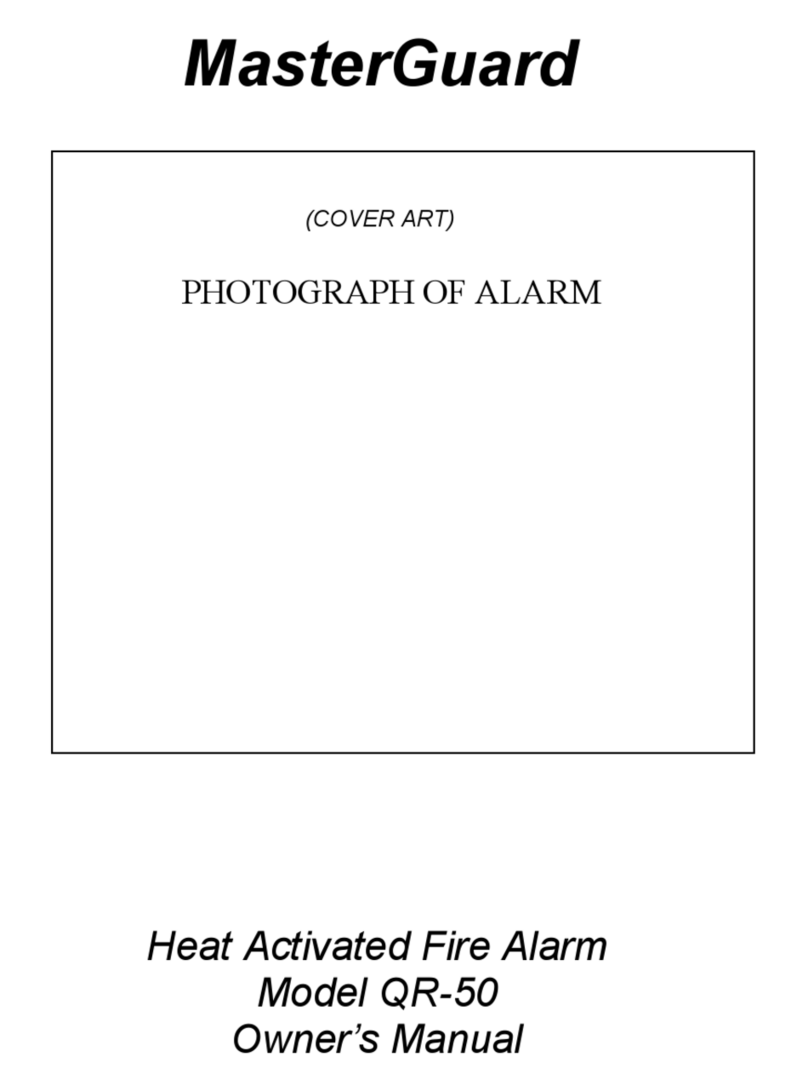
MasterGuard
MasterGuard QR-50 owner's manual

Fire Fighting Enterprises
Fire Fighting Enterprises FIRERAY 2000 EExd installation guide
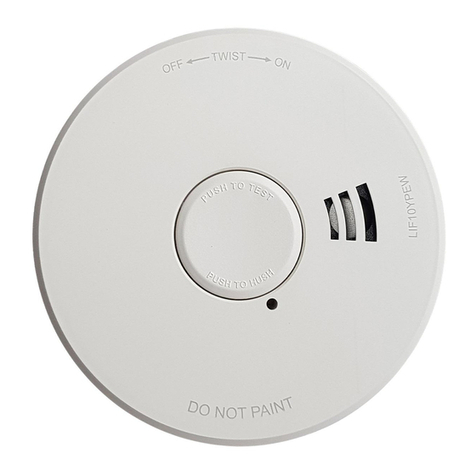
PSA Products
PSA Products LIF10YPEW user guide
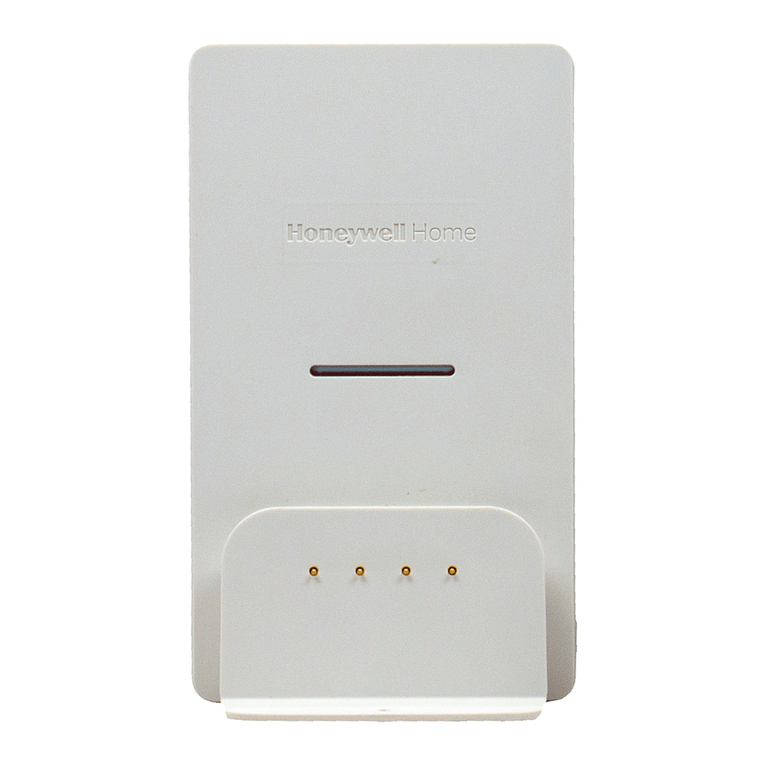
resideo
resideo HoneywellHome PROWLTOUCHWM installation guide

usi
usi USI-7385 owner's manual
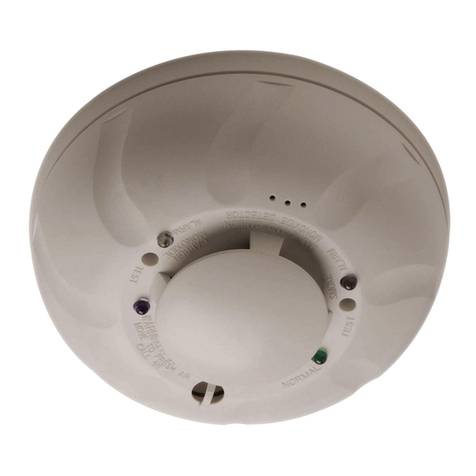
System Sensor
System Sensor i4 Series COSMO-2W Installation and maintenance instructions
